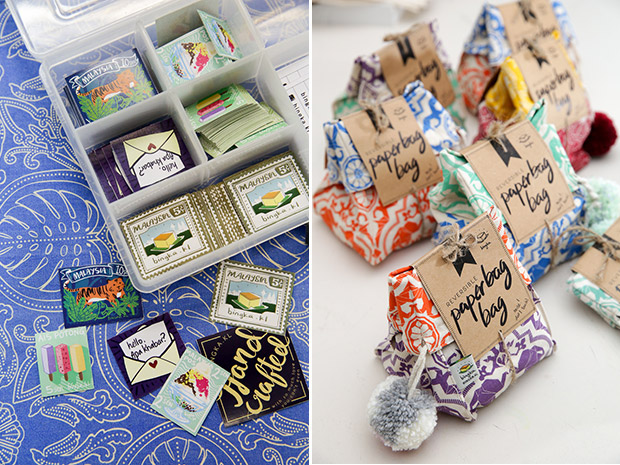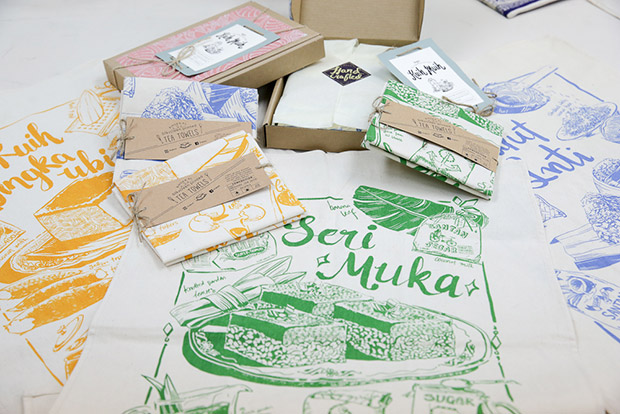KUALA LUMPUR, Feb 5 — There’s something inherently endearing about the humble kuih; colourful and bite-sized, a harmony of sweet or savoury and creamy, each a pretty little parcel of goodness. In the case of homegrown label Bingka, named after the popular steamed tapioca ‘cake’, make that many pretty parcels — pouches, tote bags, and soft home furnishings like throw pillows, coasters and tea towels.
What makes their collection stand out is that Bingka creates their own prints and makes their fabrics by hand, using the silkscreen method. Their designs and motifs pay tribute to recognisable Malaysian elements such as kuih, idyllic kampung scenes, and tropical flora and fauna. You can see it in their logo too, which immortalises their namesake as a yellow, diamond-shaped ‘cake’ on a square of banana leaf.

Their aim is to make Malaysian culture more approachable. “The younger generation don’t appreciate traditional Malaysian products such as enamel and pewter, and you hardly see any of them wear batik,” says Adrihana Abdul Rashid, one third of Bingka. Her co-founders are Ong Yi Lyn and Emmalynn Yam, both former visual effects artists who were colleagues at an Oscar award-winning studio based in Cyberjaya.
There is also, the trio had observed, a lack of variety when it comes to Malaysian souvenirs and tourists are stuck with run-of-the-mill items. “We wanted to offer not only something different but also products that even locals would want. Our approach is to keep it simple and highlight things that are close to our hearts so that one look at our designs and you instinctively know it’s Malaysian.”

Adrihana and Emmalynn, who have been friends since primary school, actually got together to start a contemporary batik fashion line at first but their efforts were met with many obstacles. “It was difficult to get the batik artists to try new ideas, or understand our point of view. They didn’t want to step outside of their comfort zone... they would rather just take the usual government jobs,” Adrihana laments. “Even though we knew that they could execute the designs we wanted, they were not keen on having free reign or our inputs,” adds Emmalynn.
It wasn’t feasible for them to make their own batik, a skill that Emmalynn says is true mastery and that takes years to develop. Still keen to produce their own fabrics, the duo (Yi Lyn only joined them after several months) decided to look into other options and silkscreen printing came to mind. They knew that T-shirt designers preferred that method as it allowed them to execute their ideas quickly. They signed up for a 12-hour workshop with Raksasa Print Studio in October 2015 and two months later, birthed Bingka as a brand.

Their very first print was the Mahagajah, inspired by Indian block printing and depicted two elephants facing each other. It’s a familiar insignia but updated by stylising the creatures in geometric shapes. “That’s our aesthetic: We take something traditional and jazz it up in contemporary styles,” says Emmalynn, who takes the lead in design. Yi Lyn manages their social media and marketing, while Adrihana handles the accounting, brand direction and also oversees production. When it comes to fabric printing, all three of them pitch in, and Yi Lyn manually stamps their brand name on the leather tags that adorn the bags and pouches.

“We don’t simply copy and paste, we don’t capture things literally but put the ideas through a design interpretation,” Adrihana emphasises. Take their logo, for example, which immortalises their namesake as a shiny, gem-like square of ‘cake’ resting on a piece of banana leaf. Taking the kuih theme further, they have a range of three tea towels that each stars a different kuih surrounded by the ingredients the respective recipe calls for. There are throw pillows shaped like and bearing a kuih appam (or ‘huat kuih’ in Chinese) motif and for this Chinese New Year, a Warhol-esque tea towel bearing tins of Cap Ayam cubed pineapples. Their bestselling item to date is the Reversible Paperbag Bag, a versatile carrier shaped after the ubiquitous brown paper bag.

Emmalynn is also particular about telling a complete story and having context to every design. Take a close look at the kampung house in one of their newest tea towels. There are waus flying behind the house and some resting beneath the stilts. As she explains, it makes sense that the wau enthusiasts that she imagines resides in the house would have a number of pieces in their collection. Many other minute details enrich the design — see if you can spot the cat, the retro telephone and gramophone.

Bingka outsources the sewing to several parties, and is following in the footsteps of social entrepreneurs by working with homemakers, refugees, migrant workers and NGOs like Dignity For Children, which strives to provides long-term quality education for underprivileged children. Bingka makes it a point to credit the people whose works are helping to shape the brand’s offerings, such as Mami, a Kajang-based homemaker whose daughter is a friend of Adrihana. Mami’s likeness, illustrated by Yi Lyn, and her story is captured on the tags of the placemats that she sews.
Bingka also accept custom orders and collaborations, though Yi Lyn is quick to point out that there are many things to consider. “For one, our fabrics are only about A3 size so we can’t make something that’s too big. Our designs are also created for a specific item, we can’t simply enlarge a print to fit another item!”

Their designs may be classic and seemingly straightforward, but the creation process is a tedious one, which requires a keen attention to detail every step of the way. “When we say handmade, there is always room for a little variation,” says Emmalynn, “but it is not an excuse for bad results.” Yi Lyn agrees: “We have to maintain a certain quality and consistency in every product.”
Emmalynn and Adrihana first sit down to discuss and agree on a theme or concept, which the former then translates into an actual design and then they get the film printed and the printing block ready. They test the printing on paper multiple times until they have worked out all the flaws and kinks, before transferring it onto fabric — they mostly use unbleached cotton, cotton canvas, and linen for the natural texture and look.

The fabrics are printed at their studio in Cheras, in small batches as their operation scale is limited to what the three of them can do. At most, they can produce about 100 pieces of A3-sized cloths in a day.
Emmalynn then sews (she had to take lessons when Bingka started up) the prototype. The trio also spends a lot of time sourcing for the right finishing details and embellishments, and even more on the colour selection. “It’s strenuous but we take pride in it... colour choice is often overlooked in Malaysian designs whereas we put a lot of thought into it,” Emmalynn explains. “We always choose hues that bring out the best of the print. We care about what our customers get in the end and how they enjoy the product.”

Like the perfect recipe, Bingka is delighting Malaysians with their original designs that celebrate the very things that are intrinsically us. That they’re hitting the right notes with their Malaysiana inclinations is really no surprise. As the trio behind the brand puts it: “Kuih is sweet, very Malaysian and relatable.”
Contact Bingka at bingka.design@gmail or connect with them on Facebook (www.facebook.com/bingkaKL/) or Instagram (www.instagram.com/bingka.kl/).
Catch them at PUAS Fest (www.facebook.com/puasfest/) from February 10-12, 2017.
Vivian Chong is always on the lookout for a good bingka and other kuihs. Follow her food trails at http://thisbunnyhops.com/






















